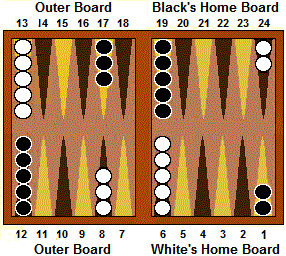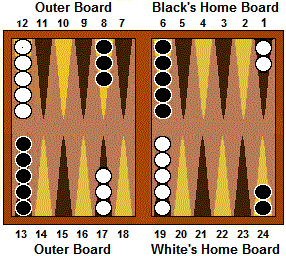|
|||||||||||||||||||||||||||||||||||||||||
|
Backgammon Notation Books on Backgammon and other related literature will use a standard numbering and notation system to describe the dice rolls and movement of checkers made during the play of a game. You can learn about the conventions commonly used for it, here. Since the 1980s, the modern backgammon game notation described here has been generally accepted as the standard. Today a 24 point numbering system is used to indicate the movement of players' checkers. Prior to this, another method was used in which the points were numbered from 1 to 12 twice, one set of numbers for each side of the board for the two different players, with points notated as W1 to W12 and B1 to B12 indicating white and black's points on their player's side of the board. The new notation system is considered clearer and less confusing. Modern Backgammon notation was first invented by Paul David Magriel Jr, a professional Backgammon player who also plays Poker, in the 1970s. He has also published a number of highly regarded books on Backgammon and is considered one of its best players and an expert on the game as well as an expert on mathematical probability. The Two Players' Moves The two players' moves are recorded on a game's notation sheet in two separate columns, one for each player, numbered according to both players' turns at rolling the dice and moving their checkers. (An example Backgammon notation sheet is illustrated below.) The standard notation in the two player's columns is described as follows: The 24-Point Numbering System Each point is numbered from 1 to 24 from the point of view of the player whose turn it is to play. So there are two sets of numbers used, one for each player, starting at 1 in each player's home-board and going up incrementally to 24 in their opponent's home-board. One player's 1-point is their opponent's 24-point, and a player's 20-point is their opponent's 5-point, etc. Of course, checkers always move to a lower numbered point as they are moved around to their player's home-board.
Notating Dice Rolls Each player's dice rolls in each turn are notated in each row as two numbers separated by a hyphen/dash ("-"), ending with a colon (":"). For example, a roll of a 6 and a 4 is notated as "6-4:" followed by the checkers' moves in the same row (see the example). Sometimes the two dice values are notated as a two digit number without the dash separating them, but including the dash is considered clearer.
Notating Checkers' Moves Each player's moves of their checkers to different points around the board is notated according to the 24 point numbering system, as the point number that the checker was moved from, followed by a slash ("/"), then the point number the checker was moved to. For example, if a checker was moved from a player's 8-point to their 4-point it is notated as "8/4", and a checker moved from their 11-point to their bar-point (7-point) it is notated as "11/7". If a checker is moved by more than one single dice value it isn't necessary to show all the dice values as separate moves, just show the checker's final destination point where it ends up. For example, if a player rolls a double-5, and they move a single checker from their 18-point by a total of 10 points, then it is notated as "18/8", not "18/13/8". You don't need to show any intermediate points. The exception to the rules is when a checker is moved more than one of the available dice values available and it is moved to a blot, hitting a checker that is sent to the bar, and then subsequently moved again to another point. In this case, the move is notated with the intermediate hit of the checker move with an asterisk ("*"). For example, if a player rolls 4 and 6 with their dice and they move their checker from their 12-point to their 8-point where it hits their opponent's single checker (blot) and they then move it again to their 2-point, it is notated as "12/8*/2". An asterisk is used when a single checker on a point (blot) is hit and sent to the bar (see the example notation). When a player rolls a double with their two dice and more than one checker is moved from an individual point, then it is customary to notate how many checkers were moved by writing the usual point numbers divided by a slash ("/") followed by the number of checkers moved between two brackets ("()"). For example, if a double-5 is rolled and two checkers are moved from their player's 12-point to their 7-point it is notated as "12/7(2)". As mentioned previously, if a player hits any of their opponent's lone checkers on a point (blot), then the player's move is notated as a hit by writing an asterisk ("*") next to the point number the blot was on. For example, if a player moves a checker from their 10-point and hits a blot on their 4-point it is notated as "10/4*". If a player's checker(s) are hit and sent to the bar, then when they are brought back into play the checker's original position is notated as "bar" followed by the destination point number. For example, if a checker is brought into play from the bar to the player's 23-point it is notated as "bar/23". When a player's checker is borne-off the board, then it is notated as the point in their home-board where it was moved from, followed by the usual slash ("/"), and then with the word "off". So a checker borne-off from a player's 5-point, is notated as "5/off". If a player is unable to make a move in their turn, then it is notated in their column and row as "no play". Doubling Using The Doubling Cube When a player doubles using the doubling cube, then it is notated in their column as "Double to #", where the # is the multiple of two that has been turned face-up on the doubling cube. It is then notated in the other player's column by the word "take" to indicate that it has been accepted, or "pass" to indicate that it has been declined and the game forfeited.
|
||||||||||||||||||||||||||||||||||||||||
|
Copyright © 2022 Stormdark I.P. and Media. All rights reserved. www.backgammon-play.net This site is for personal use only and content may not be copied or reproduced in any form for any purpose. Terms & Conditions Advertising |
|||||||||||||||||||||||||||||||||||||||||




